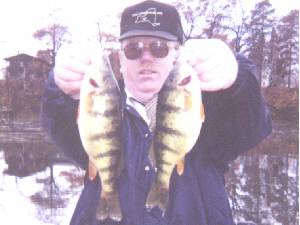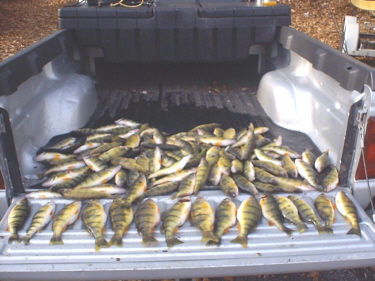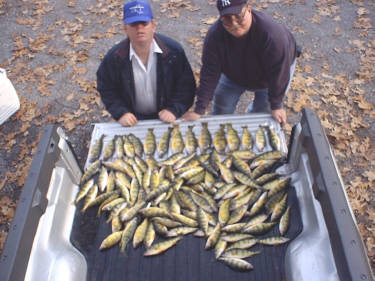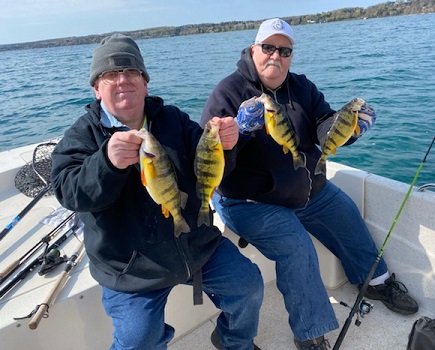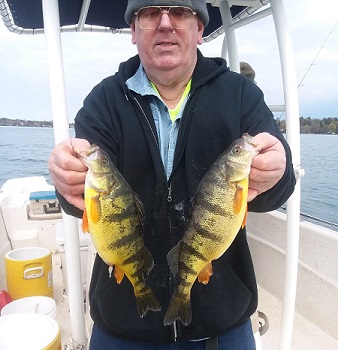Yellow Perch are found in most all of New York's lakes and rivers. In recent years the perch populations have seen radical changes. In some waters they have become scarce and others they are thriving. This is caused by a wide variety of factors including drought, acid rains, and introduction of exotic species. Perch are a highly sought after game fish in early spring and are the bread and butter for ice fisherman. Perch average about 6 to 14 inches in length with most being in the 10 inch area. Recently N.Y. State instituted a 50 fish limit for perch which should help stop over harvesting. The state record Yellow Perch weighed 3 lb. 8oz. This fish was caught by George Boice on a perch minnow from Lake Erie in April 1982.
The Yellow Perch will feed on a variety of items including small minnows, insects, crayfish, worms, eggs and the small fry of other fish. Perch prefer deeper water with cover or drop offs and will congregate on the deeper side off weed beds. Pier pilings and brush also attract and hold these fish as well. Perch also provide a forage base for larger fish such as pickerel, walleye, northern pike and muskellunge.This is one reason cover is a must for perch. When the water temperatures are to warm perch will leave the cover and seek deep open water and roam the lake in large schools where they find safety in numbers.
The Finger Lakes in central NY are fantastic for perch fishing. With Seneca Lake being the number one spot for big perch. Locals call them elephant perch. Every year perch in the 2 to 3 pound range are caught here. Two pound perch are common. In the last few years the lake has been drawn down low for the winter and there has not been sufficient precipitation to raise the lake back to normal level for spring fishing.This has resulted in reduced spawning for perch. Seneca Lake is a deep glacier carved lake and has more deep water than shallow.The low water levels raised havoc with the weed beds that perch need for spawning. Ironically the introduction of the zebra mussel has cleared the water even more so weed beds are now starting to grow in deeper water.This should help the perch poulation in the years to come. The pike have really benefited from the deep water weed beds and have seen a big population boom. This also hurts the perch population cause pike are one of the biggest predators for perch.
Lake Ontario has many bays and inlets which provide great perch fishing as well. Sodus Bay is a fantastic hot spot for ice fishing for perch and in the spring boat fisherman do well here.The Oak Orchard Creek area has a large run of perch in late March and early April from the lake. Most fish are about 8 to 10 inches long but it is not stop action just toss out a small chunk of worm on the bottom and wait, but not long its fast and furious. Fairhaven, Oswego Harbor and the Erie Canal system are also great spots for perch fishing. Oneida Lake is also a fabulous fishery for yellow perch as well as walleye and smallmouth bass.
Suggested tackle for yellow perch would be any ultra light outfit with 2, 4, or 6 pound test line. Small jigs and spinners fished slowly just off the bottom will trigger active perch to bite. Then more may be tempted with live bait. A small fathead minnow fished on the bottom with a small split shot on a thin aberdeen wire hook is the most productive method for perch. If the bottom is weedy or snag infested try using a slip float with the bait set one to two feet off the bottom. Night Crawlers can be used in the same way. Perch are great bait thieves so only use one half of a night crawler at a time. Thread the bait on the hook to give it a natural presentation don't bunch it on the hook. Fishing with worms for perch may also produce bullheads, catfish, bass, trout, bluegills, crappies, pike, pickerel, walleyes, and suckers.
|






